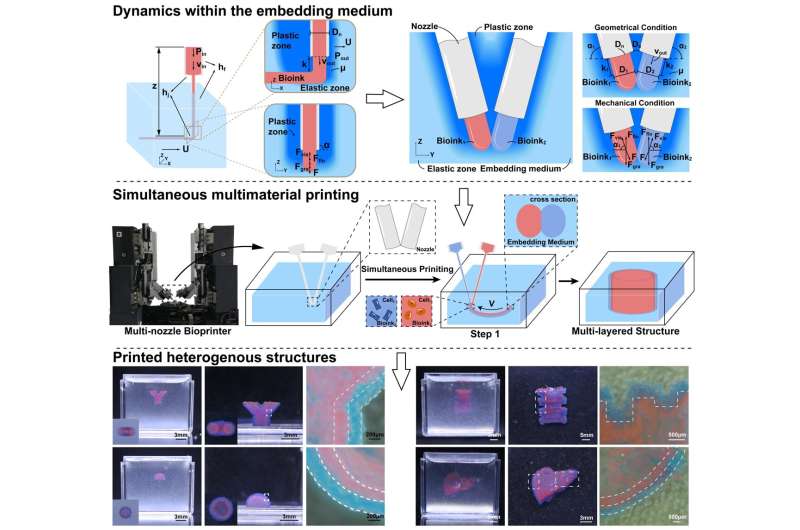This article has been reviewed according to Science X's editorial process and policies. Editors have highlighted the following attributes while ensuring the content's credibility:
fact-checked
proofread
Simultaneous multi-material embedded printing for 3D heterogeneous structures

Publishing in the journal International Journal of Extreme Manufacturing, the team led by researchers based at the State Key Laboratory of Fluid Power and Mechatronic Systems deposited different biomaterials simultaneously and precisely into the yielded region of embedding medium with multiple individually controlled nozzles.
Compared with the traditional sequential printing method, the developed printing method could control the accurate deposition of bioink to ensure the position fidelity and structure morphology and improve the bonding strength between layers. The finding could provide the potential to be widely used in manufacturing heterogeneity structures with soft biomaterials and soft composites.
One of the lead researchers, Associate Professor Hongzhao Zhou, commented, "multi-material bioprinting technology provides different choices of cells and biomaterials for the in vitro construction of heterogeneous structures that may be a better representation of natural tissues/organs. Embedded printing technology provides more possibilities for printing various materials to complex three-dimensional structures."
Nevertheless, the embedding medium has a viscosity greater than air, which would affect the continuous position of the extruded bioink more significantly. The bioink is deposited in the embedding medium and kept almost in situ. There's no guaranteed adhesion between the adjacent filaments. Due to the potential of constructing in vitro tissues with multiple materials, it is truly important to control the precise deposition of ink in embedding medium to construct heterogeneous tissues.
In conventional embedded printing, a simple and commonly used strategy is that the adjacent filaments are designed spatially overlapped to ensure that they can be connected with each other.
"The overlapping method has been proven effective when printing continuous structures with a single material. For complex structures with multiple materials, the overlapping of filaments may induce the uncontrolled stacking and squeezing of the adjacent filaments and jeopardize the spatial distribution of different materials in the printed structure," first author Dr. Ziqi Gao said.
"In our work, we analyze the dynamics of the extruded bioink in the embedding medium. We evenly mix fluorescent microspheres into the ink to determine the contour of the printed filaments, and print the filaments simultaneously in the embedding medium with different printing parameters. We can compare and verify the experimental phenomena with the results of key parameter changes in theoretical analysis. This novel printing method can achieve horizontal connection between fine threads under a wide range of printing parameters."
Co-first author Professor Jun Yin added, "Through the above experimental methods, the effects of printing parameters including printing speed, rheology of embedding medium on the 3D morphology of the printed filament are quantitatively evaluated. Under the conditions of high printing speed and low viscosity embedding medium, simultaneously printed filaments exhibit high accuracy and aspect ratio close to 1, which can adapt to the slice trajectory and enable us to manufacture micro structures."
"Double-layer thin-walled structure with each layer less than 200 μm was printed. It was demonstrated that intestine and liver models could be printed. The intestine showed a structure similar to the circular fold shape of the real organ. Both the tissues can be crosslinked and extracted from the embedding medium without significant impairment or delamination."
"Also, a peeling test was carried out to investigate the bonding strength between simultaneous printed specimen, results were compared with the casted and sequential printed specimen. We found that the bonding strength of the samples by simultaneous printing was significantly greater than that of the samples by sequential printing under the same trajectory. The proposed simultaneous printing method has minimized the chance of the contamination of the embedding medium for the 3D printing of multi-layered and multi-material structures. And it could be a direct solution of the present structural integrity problems for such structures."
The team studied a multi-material embedded printing method that is promising for fabricating heterogeneity structures with high precision and good structural integrity. With soft biomaterials and soft composites, this method may be potentially used for the construction of in vitro tissue model.
More information: Ziqi Gao et al, Simultaneous multi-material embedded printing for 3D heterogeneous structures, International Journal of Extreme Manufacturing (2023). DOI: 10.1088/2631-7990/acd285
Provided by International Journal of Extreme Manufacturing





















